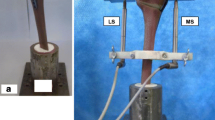Abstract
Background
The implantation of total ankle prosthesis is one of the most challenging operations in orthopaedic surgery. The main problem that surgeons face is the fixation of the total ankle prosthesis on the tibial side. The subchondral bone plate of the distal tibia is considered the strongest region on the inferior tibial facies. Based on information about the mineralisation of the subchondral bone plate, conclusions can be made concerning the mechanical stress, age-related changes, post-surgical biomechanical situations and regions of fixation. The aim of this study was to determine the correlation between the mineralisation of the subchondral bone plate and the topical mechanical strength.
Methods
By means of CT-osteoabsorptiometry, the distribution of mineralisation in the subchondral bone plate in 18 distal Tibiae was investigated. After removal of the cartilage of the facies articularis inferior, the mechanical strength of the joint surface was measured with an indentation apparatus. The linear regression of the mineralisation density and the maximal mechanical strength to penetrate the subchondral bone plate was determined.
Results
Our data showed a coefficient of determination between 0.75 and 0.97 and a coefficient of correlation between 0.86 and 0.97. The T test showed significance (P < 0.05). Furthermore, we demonstrated a bicentric distribution of mineralisation patterns. The maximal mineralisation was found ventromedially and mediolaterally on the joint surface.
Conclusion
Our study shows good correlation of mineralisation and mechanical property of the inferior tibial facies. Therefore, as the results provide information on the topographical distribution of bone quality, they could be useful for the development of new fixation methods for total ankle prosthesis.








Similar content being viewed by others
References
Aitken GK, Bourne RB, Finlay JB, Rorabeck CH, Andreae PR (1985) Indentation stiffness of the cancellous bone in the distal human tibia. Clin Orthop Relat Res 201:264–270
Dörenberg KO (1983) Kontaktflächen und anatomische Gelenkflächen des oberen Sprunggelenks- Methoden zur Bestimmung der Flächengröße und Falldarstellung. Morphol Med 3:97–108
Gabrion A, Jarde O, Havet E, Mertl P, Olory B, de Lestang M (2004) Ankle arthrodesis after failure of a total ankle prosthesis. Eight cases. Rev Chir Reparatirice Appar Mot 90(4):353–359
Hintermann B, Nigg BM (1995) Influence of arthrodeses on kinematics of the axially loaded ankle complex during Dorsalflexion/Plantarflexion. Foot Ankle Int 16:633–663
Hoffmann AA, Hammon DJ, Daniels AU (1991) Compressive strength mapping of femoral head trabecular bone. J Rehabil Res 28(2):25–32
Hopgood P, Kumar R, Wood PL (2006) Ankle arthordesis for failed ankle replacement. J Bone Joint Surg Br 88(8):1032–1038
Hvid I, Rasmussen O, Jensen NC, Nielsen S (1984) Trabecular bone strength profiles at the ankle joint. Clin Orthop 199:306–312
Kofoed H, Stürup J (1994) Comparison of ankle arthroplasty and arthrodesis. A prospective series with long term follow up. Foot 4:6–9
Lachiewicz PF, Inglis AE, Ranawat CS (1984) Total ankle replacement in rheumatoid arthritis. J Bone Joint Surg 66A:340
Leicht P, Kofoed H (1992) Subtalar arthrosis following ankle arthrodesis. Foot 2:89–92
Müller-Gerbl M (1998) The subchondral bone plate. Adv Anat Embryol Cell Biol 141(III-XI):1–134
Müller-Gerbl M, Putz R, Hodapp N, Schulte E, Wimmer B (1989) Computed tomography-osteoabsorptiomety: a method of assesing the mechanical condition of the major joints in a living subject. Clin Biomech 5:193–198
Müller-Gerbl M, Putz R, Kenn R (1992) Demonstration of subchondral bone density patterns by three-dimensional CT osteoabsorptiometry as a non-invasive method for in vivo assessment of individual long-term stresses in joints. J Bone Miner Res 2:411–418
Müller-Gerbl M, Putz R, Hodapp N, Schulte E, Wimmer B (1990) Demonstration of subchondral density pattern using CT-osteoabsorptiometry (CT-OAM) for the assessment of individual joint stress in live patients. Z Orthop Ihre Grenzb 128:128–133
Müller-Gerbl M, Putz R, Hodapp N, Schulte E, Wimmer B (1989) Computed tomography-osteoabsoptiomety for assessing the density distribution of subchondral bone as a measure of longterm mechanical adaptation in individual joints. Skeletal Radiol 18:507–512
Müller-Gerbl M (1990) Die Darstellung der subchondralen Dichtemuster mittels der CT-Osteoabsorptiometrie (CT-OAM) zur Beurteilung der individuellen Gelenkbeanspruchung am Lebenden. Z Orthopädie 128:128–133
Müller-Gerbl M (2008) The distribution of mineral density in the cervical vertebral endplates. Eur Spine J. doi:10.1007/s00586-008-0601-5
Müller-Gerbl M et al (2001) Anatomy and biomechanics of the upper ankle joint. Orthopäde 30(1):3–11
Müller-Gerbl M, Putz R (1991) Funktionsbezogene Anatomie des oberen Sprunggelenks. In: Heim UFA (Hrsg) Die Pilon-tibial-Fraktur. Springer, Berlin
Natens P, Dereymaeker G, Abbra M, Matricale G (2003) Early results after four years experience with the S.T.A.R. uncemented total ankle prothesis. Acta Orthop Belg 69(1):49–58
Procter P, Paul JP (1982) Ankle joint biomechanics. J Biomech 15:627–634
Rudigier R, Grundel H, Menzinger F (2001) Prosthetic 2001 replacement of the ankle in posttraumatic arthrosis. Eur J Trauma 27:66–74
Saitoh S, Nakaksuchi Y, Latta L, Milne E (1994) Distribution of bone mineral density and bone strength of the proximal humerus. J Shoulder Elbow Surg 3:234–242
Schmidt IM, Jäger M (1984) Anatomische Studie an 400 Leichensprunggelenken unter besonderer Berücksichtigung möglicher Varianten bezüglich Beschaffenheit und Verlauf der fibularen Bändern (Ergebnisse und klinische Relevanz). In: Hackenbroch, Refior HJ, Jäger M, Plitz W (Hreg) Funktionelle anatomie und Pathomechanik des Sprunggelenks. Thieme, Stuttgart New York
Stauffer RN (1982) Salvage of painful total ankle arthroplasty. Clin Orthop 170:184
Stauffer RN, Segal NM (1981) Total ankle arthroplasty: four years experience. Clin Orthop 160:217–233
Wood PL, Deakin S (2003) Total ankle replacement. The result in 200 ankles. J Bone Joint Surg Br 85(3):334–341
Author information
Authors and Affiliations
Corresponding author
Rights and permissions
About this article
Cite this article
Mühlhofer, H., Ercan, Y., Drews, S. et al. Mineralisation and mechanical strength of the subchondral bone plate of the inferior tibial facies. Surg Radiol Anat 31, 237–243 (2009). https://doi.org/10.1007/s00276-008-0430-6
Received:
Accepted:
Published:
Issue Date:
DOI: https://doi.org/10.1007/s00276-008-0430-6




